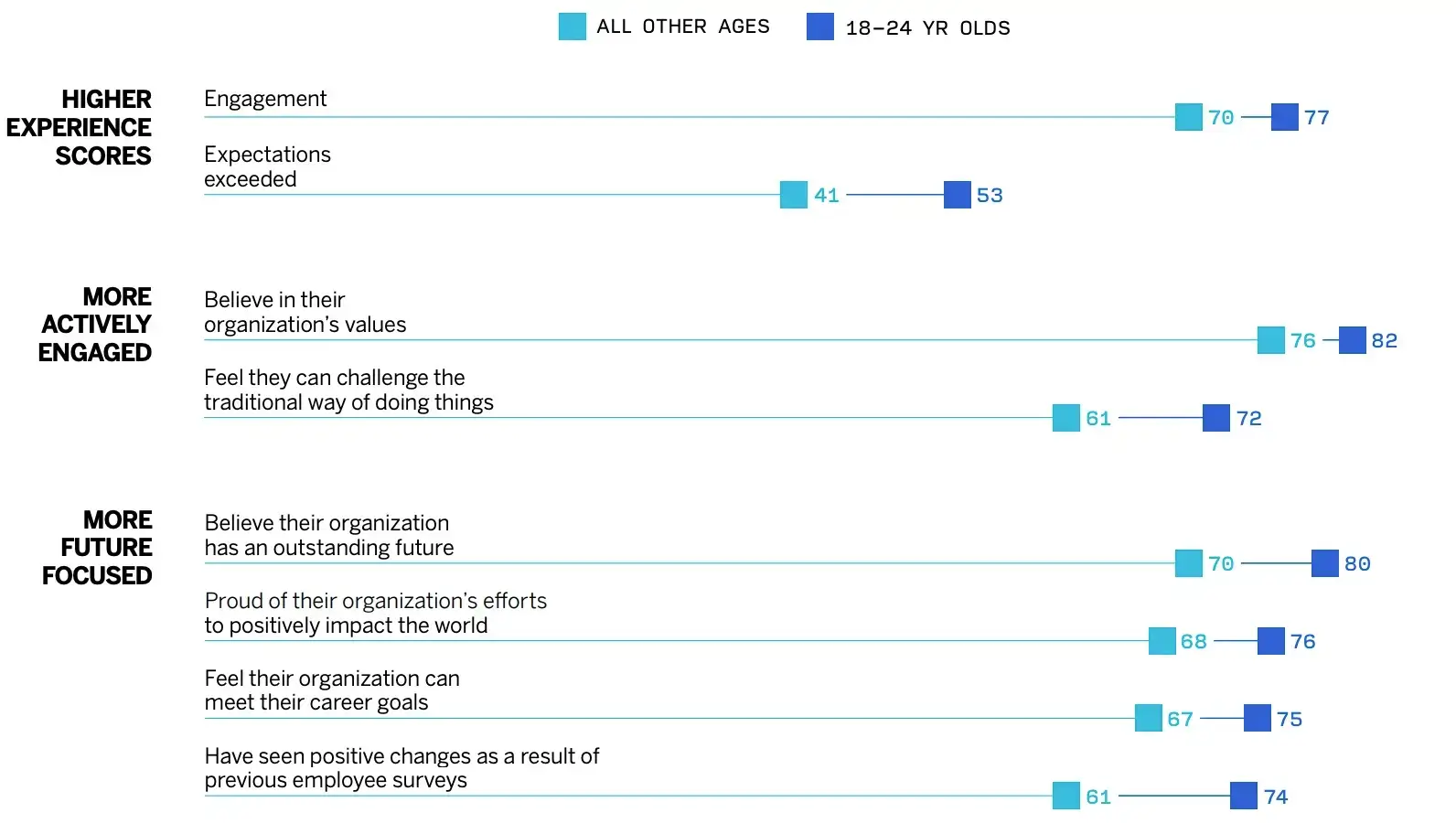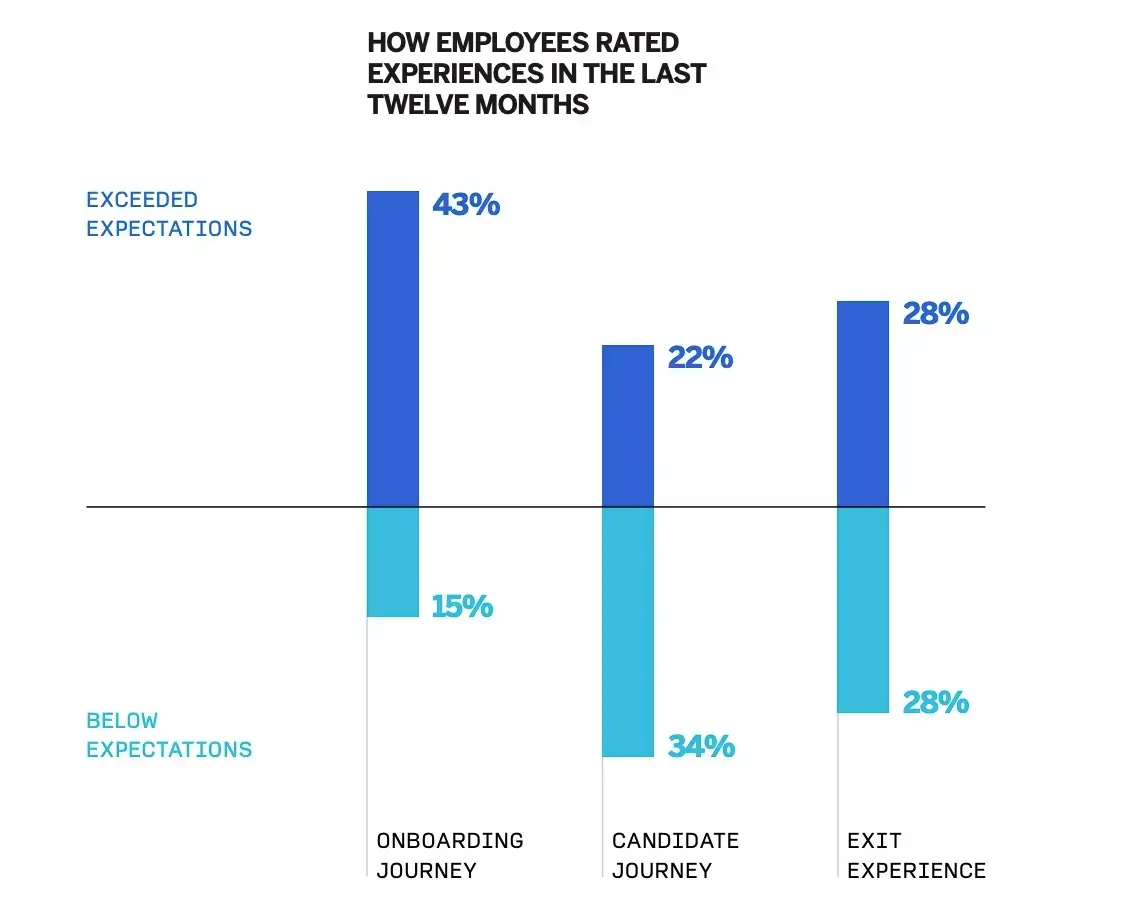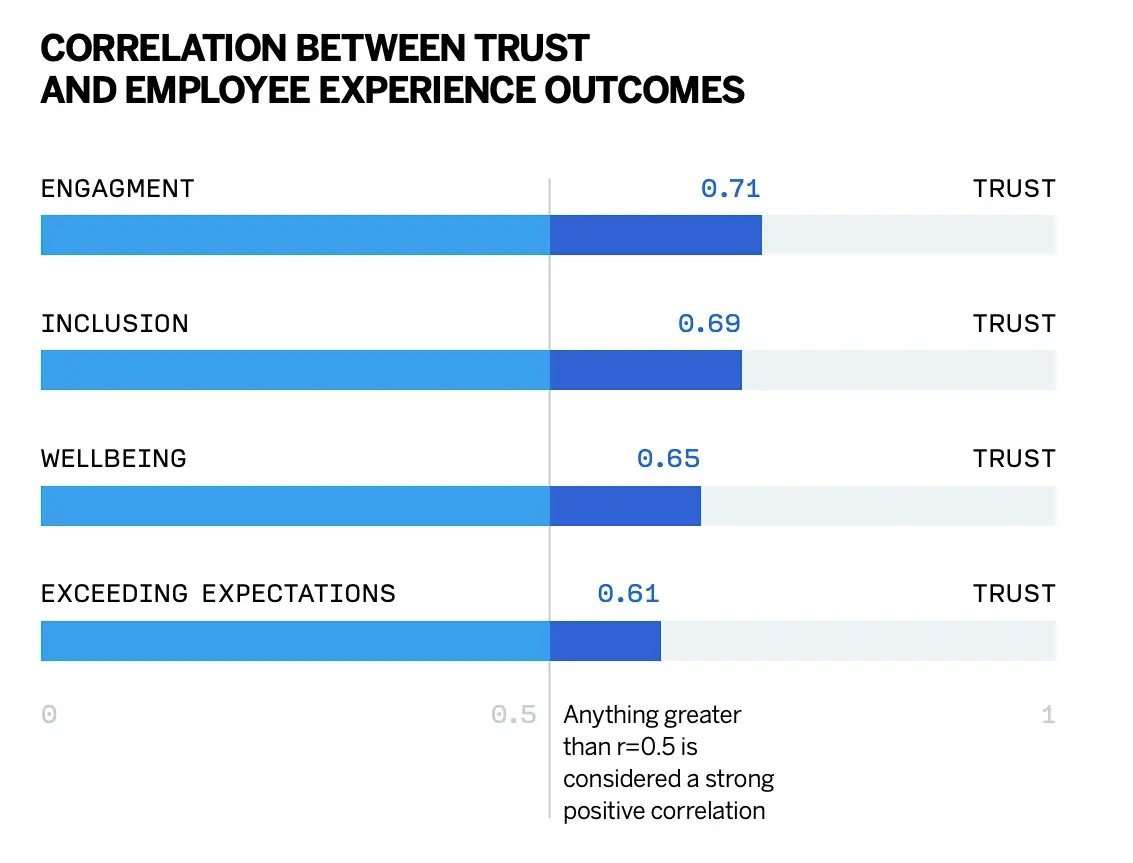
Employee Experience
The 5 employee experience trends redefining work in 2025
35,000 employees. 22 countries. 30 industries. 5 workplace-defining trends. Here it is – our 2025 Employee Experience Trends Report, to help you navigate the modern workplace.
Each year, we track the core employee experience metrics across the world to understand work: what’s shaping it, what’s redefining it, and what’s staying the same. Our findings give leaders and organizations at-a-glance and comprehensive insight into what matters in the year ahead, and expert advice on how to act.
What’s the current state of play?
The past few years have been chaotic — so much so that organizations are devoting more and more time and effort to business agility and resilience, hybrid work models, enhancing productivity, and activating artificial intelligence (AI) at scale to help navigate uncertainty.
But while leaders are focused on the future, and everything other than work itself, employees have been forced to adapt and find their own solutions, often using outdated systems and processes with little to no support.
As well as addressing technological and operational challenges, organizations must also rethink the experiences they deliver: where job applications, onboarding and exiting used to be priorities for organizations, these foundational experiences have become somewhat lost and deprioritized among constant change and focus shifts.
We’ve forgotten that first impressions and final impressions are hugely significant for employee perceptions of a business.
We also found trust to be a recurring theme this year: are business decisions driven by people, or profit? Will senior leaders be less benevolent and prioritize profit over people, or more benevolent, having employees’ backs and taking a financial hit to help them if they’re struggling? Benevolence matters to employees.
There is, however, some cause for celebration; we discovered that despite comments about their work ethic and commitment, employees under 25 are more enthusiastic, actively engaged, and proud of their organizations than any other age group.
The challenge here is: how can we continue to create the kinds of experiences that motivate, engage, and retain this segment of the workforce?
Finally, AI. Widespread surge in adoption has meant that for the vast majority, AI is now part of the everyday. But while it’s a powerful tool, organizational maturity and enablement lag behind.
Overall, our findings yet again demonstrate one unassailable fact: the human workforce remains the true backbone of every organization.
Let’s dig into the main findings of the report, and see how technology can help.
Download the full 2025 EX trends report here
Trend 1: 2025’s best employers will make work less chaotic
Between the pressures of the every day and the demand for higher productivity, employees have been forced to adapt to change and uncertainty time, and time again over the past few years.
But while employees have gone above and beyond to meet ever-increasing expectations, organizational systems and processes have lagged behind, leading to a situation where work feels harder and more complex than ever for employees.
For more than a third of employees, there’s unrelenting pressure to increase productivity, despite the inefficiencies of current systems and processes.
- 38% of employees are feeling pressure from their employers to increase productivity
When we dug into what’s causing these issues, employees said they’re due to:
- Pace of change (38%)
- Strategic efforts (36%)
- Economic conditions (34%)
Therefore, to keep employees engaged and well within themselves, the priorities (and top drivers for success) in 2025 are:
- Simplifying processes to enable employees to meet customer needs
- Improving how work gets done
- Developing new ways to serve customers
People adapt faster than systems do, that much is clear — but it’s vital that leaders join their employees on this journey to eliminate poor experiences and streamline work.
How technology can help
The global economic outlook for 2025 suggests that the pressure on employees is likely to continue, with rapid change and disruption becoming the norm.
GIven how complex work has become, it’s never been more important for organizations to listen to and understand the needs of their people, whether they’re struggling with processes, or disengaged.
What you hear will help you enhance processes, supply the right tools, remove unnecessary red tape, and empower employees to be autonomous.
And the appetite for listening is growing. In 2024, only a third (35%) of employees were being asked for feedback more frequently than once a year. But, in 2025, this has risen to nearly half (48%).
Traditional methods of employee listening, such as the annual and quarterly survey, are no longer enough alone. Instead, consider using multiple methods to understand what your people want and need, without interrupting their work:
- Engagement solutions and frequent pulsing to tap into employee sentiment
- Passive listening to tap into the data employees generate as part of their day-to-day activities without extra effort on their part (e.g. work emails, communication channels) — 59% of surveyed employees are comfortable with this
- Empower leaders and managers with modern, AI-powered XM solutions that summarize employee feedback at scale to uncover meaningful and actionable insights
Trend 2: Young employees are (surprisingly) the most optimistic… for now
We found that people aged under 25 are the most engaged and positive of all the employee groups, which contradicts media narratives that young employees are quiet quitters with less work ethic and commitment.
Not only are they enthusiastic, they’re also more keen than any other age group to bring value to their organizations, and are incredibly optimistic about its future.
Compared to all other ages, of employees aged under 25:

However, today’s enthusiastic young people have a whole raft of pressures: the cost of education, cost of living, mental health, new ways of working, and desires for training and career growth that often make them unable to commit to one organization for an extended period of time.
How technology can help
You want to hang onto your bright, optimistic, enthusiastic young people for as long as possible — but doing so requires understanding what helps them to stay.
The top factors that make 18–24-year-olds want to stay at an organization, in order of rank, are:
- Their career aspirations can be met
- The employee benefits meet their needs
- Managerial behavior is consistent with company values
- Belief in the company values
- Meaningful career development discussions with their manager
Employee journey analytics are pivotal. They help highlight the moments that matter along the employees lifecycle. For example, organizations can look at whether under 25s have been onboarded and trained properly based on feedback at these key junctures. They can also focus on one-to-one meetings with managers and highlight areas for improvement.
Also, make full use of tools that uncover attrition factors in different segments of your workforce so you can identify why your younger employees leave.
Lastly, actively include your younger workers in discussions; ask them for ideas and encourage suggestions for development and improvement. Listen well (while managing expectations of the more blue-sky thoughts), but most importantly – act and show younger workers you care about them.
Trend 3: Employee experiences are being ruined by entry and exit
In 2024, we found that the ‘honeymoon period’ for new employees was over, highlighting how onboarding was in dire need of improvement.
In 2025, the honeymoon period still hasn’t returned — but when we asked employees abot their experiences over the last 12 months, we discovered there are experiences rated worse than onboarding.

Why is this important? Well, entrance and exit experiences strongly influence the relationship between the organization and its potential employees and customers.
First and last impressions are powerful, so much so that positive experiences often lead to employees and customers becoming advocates, while negative experiences can tarnish a brand’s reputation and recruitment drives.
Organizations that don’t gather information from their incoming and outgoing employees miss out on vital data that reveals the reasons why people leave or stay, and even alienate potential brand ambassadors.
How technology can help
Your organization’s relationship with potential employees and current employees (who may also be your customers and brand advocates) is shaped by the quality of their candidate and exit experiences.
Why does this matter? Well, good experiences leave positive impressions. When experiences fail to meet expectations, organizations can potentially lose employees or customers who could have become advocates. Instead, they tell others about the low quality of their experiences or interactions.
Again, employee journey analytics are helpful here, as they can help identify areas along the lifecycle that are lacking and need action. With these capabilities, problems with candidate and exit experiences will swiftly reveal themselves.
People analytics tools will help you uncover the reasons why some people leave and some stay so that you can focus on making the candidate experience the best it can be.
Engage your new hires from the very beginning so that they have positive employee experiences and perception of the organization, and use 360 feedback to pick up on areas of focus and improvement.
Trend 4: Prioritizing short-term gains is costing you long-term trust
Across the globe, the importance of customer and employee trust is becoming increasingly salient for leaders as they navigate more volatile and uncertain environments.
The fact is that trust is foundational to human experiences. It predicts how people will interact with each other, with technology, organizations, and much more.
This is vital because when people trust, they:
- Are proactive
- Take on board messages
- Change behaviors
- Forgive mistakes
- Advocate for the organization unprompted
And there’s a clear correlation between trust and employee experience outcomes.

So, what are the core components of trust?
- Competence - Having the skills and knowledge needed to do a job well
- Integrity - Behaving in a way that’s consistent with the organization’s values
- Benevolence - Choosing employee well being over immediate profit or gain
For the most part, employees trust their leaders, with a 63% favorability rating across the globe.
But while employees generally don’t have a problem with their leaders’ competence and integrity, they’re less likely to believe that their leaders will act with benevolence.
- 68% of employees believe their leaders are competent
- 67% of employees believe their leaders’ behavior aligns with the organization’s values
- BUT only 56% of employees feel that their leaders will act with benevolence
How technology can help
There’s a simple response to this trend: listen, understand, act. It’s relatively easy to demonstrate competence and integrity, but it’s benevolence that often needs more working on.
Managers fundamentally need to be open to diverse perspectives that challenge, contrast with, or differ from their own, and be courageous enough to take them on board.
Pulse surveys can really help here. They empower leaders and managers to get feedback quickly and accurately, not only from their team, but also from beyond their immediate network.
And experience data is essential for making business decisions that affect people. This will help leaders make smarter, better decisions that affect people positively, and build trust, enhancing employee satisfaction and the whole employee experience.
Trend 5: PSA: Your team is outpacing you on AI
Our 2024 report found that employees were generally comfortable with AI, as long as it assisted them rather than managed them: 53% of engaged employees were comfortable with AI, compared to 30% of disengaged employees.
For 2025, we found that sentiment towards AI is more positive than negative. Of employees who use AI daily or weekly:
- 10% are worried about it
- 72% are optimistic about it
It’s not just optimism either — employees are actively adopting AI tools at work, with 45% already using them daily or weekly.
As for what tools they’re using and where they’re sourcing them from… that’s a bit of a mishmash:
- 23% of employees use a mix of work/personal AI sourced tools
- 30% of employees are mostly or only using AI tools they have sourced themselves
- 48% of employees are mostly or only using AI tools their company has provided
Is AI the solution to the productivity conundrum?
AI is generally trumpeted as a solution to enhance productivity, reduce employee time spent on repetitive and routine tasks, and shape the future of work. But while frequent users are enthusiastic about it, the simple use of AI doesn’t translate into increased employee productivity.
When we asked employees what they would do with their time saved by AI:
- 47% said they would increase the quality of their work
- 42% said they would do their work in less time
- 38% would engage in new tasks
- 27% would increase the volume of work they produce
Clearly, more joined-up task management work needs to be done, sourcing suitable AI tools for everyone and coming up with strategic plans that enable employees to adapt to new, higher-value work tasks – otherwise AI may do more harm than good.
How technology can help
Looking at the mixture of work issued and personally sourced AI tools that respondents to our 2025 survey report using, there’s clearly a lack of standardized guiding principles and training in the use of AI that organizations need to get a handle on as soon as possible.
Just over half (52%) of employees worldwide agree that their organizations:
- Have clear principles, ethics, or guidelines on the use of AI tools
- Provide training and enablement on the use of AI tools
There's clearly work to be done.
As adoption outstrips organizational maturity, training in the use of AI, including clear policies and practices, is vital. What’s more, organizations must frame AI as a way to increase the quality of work, not necessarily quantity.
To this end, the best people to get involved with your AI tech transformation are your HR leaders. They’re the people closest to your workforce – changing perceptions, encouraging adoption of AI and supporting your people through changes.
And of course in a period of technological change you must listen to what your workforce is saying about AI. Use real-time active and passive listening to measure employee engagement and cultural health and how these new technologies are affecting people, then step in to nip issues in the bud before they become a wider problem.
What does this all mean for you?
For HR leaders and people analytics teams, our 2025 findings provide a clear window into the top priorities for positive employee experiences and business success in the year ahead, and how to keep your employees happy.
And now, it’s time to take action.
In our 2025 Employee Experience Trends report, you can explore these 5 trends in significantly more detail.
Featuring expert analysis and commentary (from workplace psychologists and experience management professionals alike) advice broken down by job function, work forecasts, and powerful data comparisons — download your copy of the report, and chart a path forward today.
Dive deeper into the 2025 employee trends